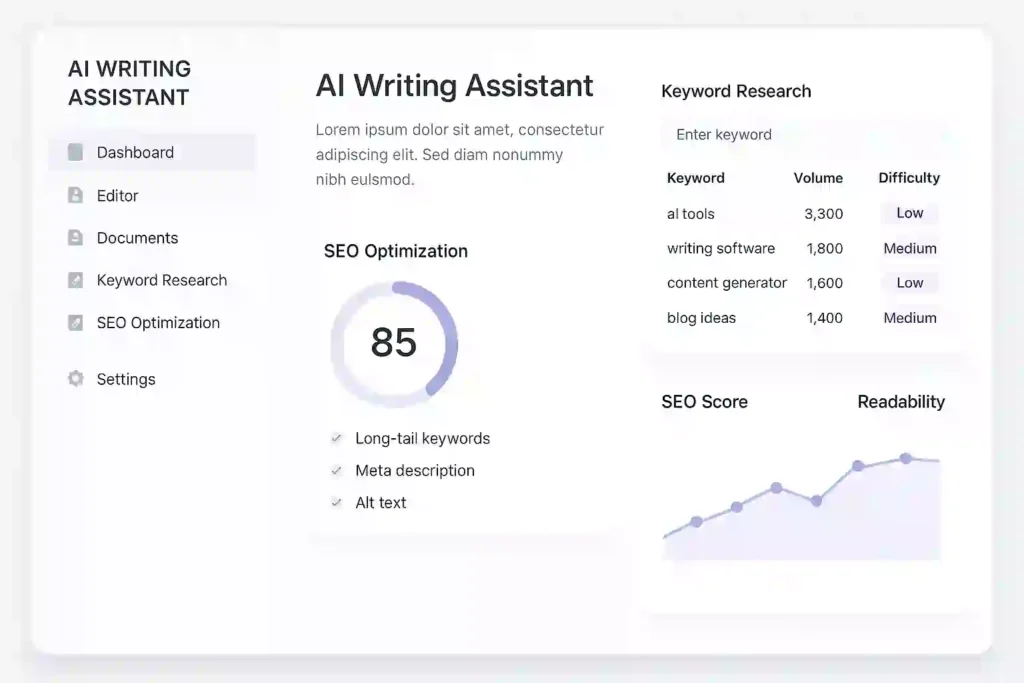
Are you looking to elevate your blogging but find yourself short on time? Consistently producing high-quality, SEO-optimized content is a common challenge for creators. This is where Artificial Intelligence (AI) tools become a game-changer, acting as your personal writing assistant.
This value-driven guide provides a step-by-step walkthrough on how to effectively use AI for every stage of your blogging process. From generating compelling ideas and conducting keyword research to drafting and refining your posts, you will learn how to streamline your workflow. Let’s explore how to Using AI Tools for Blogging these innovative tools to save time, boost creativity, and significantly improve your blog’s performance.
What is AI Blog Writing and How Can It Revolutionize Your Content Strategy?
AI blog writing is the process of using artificial intelligence to generate written content for blogs. This technology leverages advanced algorithms and natural language processing to produce articles, outlines, and other materials based on user-provided prompts. AI tools can revolutionize your content strategy by significantly improving efficiency, allowing you to produce high-quality drafts in a fraction of the time it would normally take.
This efficiency enables you to scale your content output, publishing more frequently without sacrificing quality or increasing your budget. AI also enhances your strategy by offering data-driven insights into trending topics and valuable keywords, ensuring your content is both relevant and optimized for search engines. By handling repetitive tasks, AI frees up creators to focus on higher-level strategy, creativity, and adding unique perspectives to their work.
Step 1: Streamline Your Outline Creation with AI Blog Writing Tools

A well-structured outline is the backbone of any successful blog post, and AI blog writing tools can make this process incredibly efficient. Instead of starting with a blank page, you can generate a comprehensive framework in seconds, ensuring your content is logical, focused, and easy for readers to follow.
Using AI Content Creation Tools to Generate an SEO-Friendly Brief
Before writing, it is essential to create a content brief to guide your article. AI content creation tools are perfect for this, as they can analyze a target keyword and generate a brief that includes key information such as related keywords, word count targets, and competitor headlines. This ensures that from the very beginning, your article is structured to rank well on search engines and meet user intent. By providing the AI with your topic and goals, it can produce a brief that aligns with your content strategy.
How to Craft the Perfect Blog Post Outline with AI Assistance
To craft the perfect blog post outline with AI, start by giving the tool a clear and specific prompt, such as your working title. The AI will generate a list of potential headings and subheadings (H2s and H3s) based on what is currently ranking for your topic. From there, you can review, customize, and expand on the suggestions to fit your unique perspective. For a truly comprehensive outline, use the “People Also Ask” section on Google to identify common questions and turn them into headings, further enhancing your SEO.
Step 2: Supercharge Your Content with AI-Driven Keyword Research
AI-driven keyword research is a game-changer for SEO, helping you uncover high-impact keywords that your target audience is actively searching for. AI tools can analyze vast amounts of data to identify opportunities you might otherwise miss, giving you a significant competitive advantage.
Finding High-Impact Keywords with the Best AI SEO Tools
The best AI SEO tools, such as Rank Math or SurferSEO, simplify the process of finding valuable keywords. These platforms can generate lists of long-tail keywords, secondary keywords, and keyword clusters that add depth and context to your content. By inputting your primary topic, the AI will provide a diverse list of suggestions, along with important metrics like search volume and competition, allowing you to prioritize the most effective keywords for your strategy.
How to Use AI for Keyword Analysis and SERP Insights
AI excels at keyword analysis by not only identifying keywords but also providing insights into the Search Engine Results Pages (SERPs). AI tools can analyze top-ranking articles for a specific keyword and show you what headings, topics, and questions they cover. This allows you to perform a content gap analysis, identifying subtopics that your competitors may have missed. By understanding the SERP landscape, you can create more comprehensive and authoritative content that better serves user intent.
Step 3: Fast-Track Your First Draft with an AI Writing Assistant
An AI writing assistant is an invaluable tool for overcoming writer’s block and accelerating the content creation process. These tools can generate a complete first draft based on your outline, saving you hours of writing time and allowing you to focus on refining and adding your unique voice.
Generating a High-Quality First Draft Using AI for Blogging
To generate a high-quality first draft, simply input your detailed outline into an AI for blogging tool like Jasper or Copy.ai. The AI will use your headings and any provided notes to write the body of the article, section by section. While the output is often impressive, it is crucial to remember that this is a first draft. It provides a solid foundation that you can then build upon, edit, and enhance with your own expertise and examples.
Tips for Writing Strong AI Prompts to Get Better Results
The quality of your AI-generated content is directly related to the quality of your prompts. To get the best results, be specific and provide as much context as possible. Instead of a vague request like “write about AI,” use a detailed prompt such as, “Generate a 500-word blog post section on the benefits of using AI for keyword research, targeting an audience of beginner bloggers.” Include the desired tone, format, and any key points you want to cover to guide the AI effectively.
Step 4: Perfecting and Polishing with AI-Powered Editing and Proofreading
The final step before publishing is to ensure your content is error-free, polished, and authentic. AI-powered editing and proofreading tools are essential for this stage, helping you refine your writing to a professional standard.
Using AI Tools for Advanced Proofreading and Grammar Checks
AI tools like Grammarly go far beyond basic spell-checking. They offer advanced proofreading by identifying grammatical errors, awkward phrasing, and inconsistencies in tone. These tools can analyze your content for clarity, engagement, and delivery, providing suggestions to make your writing more impactful and easier to read. This ensures your final article is professional and error-free.
How to Humanize AI-Generated Content for Authenticity and Brand Voice
To humanize AI-generated content, it’s crucial to infuse it with your unique perspective, personal stories, and brand voice. Start by editing the draft to sound more like you, adjusting the tone and vocabulary. Add personal anecdotes, examples, or case studies to provide value that AI alone cannot. Fact-check all data and claims to ensure accuracy. This hybrid approach of using AI for the initial draft and then adding a human touch ensures your content is both efficient to produce and authentic to your brand.
The Best AI Tools for Bloggers to Boost Productivity
To boost productivity in your blogging efforts, a variety of AI tools are available to assist at every stage of the content creation process. These tools are designed to streamline your workflow, enhance quality, and optimize your posts for search engines.
Top AI Tools for Bloggers:
AI Writing Assistants Tools like Jasper and Copy.ai excel at generating content, from initial ideas and outlines to full drafts. They can help overcome writer’s block and speed up the writing process significantly.
AI SEO and Content Optimization Tools Platforms such as Frase and SurferSEO are essential for keyword research and on-page optimization. They analyze top-ranking content to provide data-driven recommendations for improving your articles’ SEO performance.
AI-Powered Editing and Proofreading Tools Services like Grammarly and Wordtune use AI to go beyond basic spell-checking. They help refine your writing by improving clarity, tone, and style, ensuring your final draft is polished and professional.
The Do’s and Don’ts of AI-Powered Blogging
While AI-powered blogging offers incredible advantages, it’s essential to follow best practices to ensure your content remains high-quality, authentic, and effective. Here are the key do’s and don’ts to keep in mind.
Do: Always Fact-Check and Edit AI-Generated Content
This is the most critical rule of using AI in your workflow. AI tools can sometimes produce information that is outdated, incorrect, or fabricated. Always fact-check any statistics, claims, or data points against reliable sources. Furthermore, edit the AI-generated text to correct any awkward phrasing, improve readability, and ensure it aligns with your brand’s tone and style.
Do: Use AI to Enhance, Not Replace, Your Originality
Think of AI as a powerful assistant, not a replacement for your creativity. Use it to handle repetitive tasks like generating outlines, drafting initial content, and optimizing for keywords. This frees you up to focus on what truly makes your blog unique: your personal insights, experiences, and expertise. AI should augment your abilities, not substitute your voice.
Don’t: Publish Raw AI Output Without Human Oversight
Publishing content directly from an AI tool without any review is a significant mistake. Raw AI output often lacks the nuance, context, and personality that readers connect with. It can also contain factual errors or sound generic. Always perform a thorough review to ensure the content is accurate, engaging, and provides genuine value to your audience. Google’s guidelines emphasize rewarding high-quality content, regardless of how it’s produced, so human oversight is key.
Don’t: Rely Solely on AI for Niche Expertise and Unique Insights
AI models are trained on vast amounts of existing data, which means they can’t generate truly original thoughts or provide expertise based on real-world experience. For topics that require deep niche knowledge, personal stories, or unique perspectives, your human input is irreplaceable. Relying solely on AI for this kind of content will result in generic posts that fail to build authority or connect with your readers on a deeper level.
Understanding the SEO Implications of AI Content Creation
As AI content creation becomes more widespread, it is essential to understand its relationship with search engine optimization (SEO) and how to use it responsibly. Navigating Google’s guidelines is key to leveraging AI effectively without facing negative consequences.
Is AI-Generated Content Good for SEO? What Google Says
Google’s stance on AI-generated content is clear: it rewards high-quality content, regardless of how it is produced. The use of AI is not inherently against Google’s guidelines. The focus is on creating content that is original, helpful, and prioritizes the user’s needs over simply trying to manipulate search rankings.
Google’s main concern is spammy, low-quality content that offers no real value to the reader. Therefore, if you use AI to produce well-researched, accurate, and people-first content, it can be perfectly good for SEO. The key is to adhere to the principles of E-E-A-T (Experience, Expertise, Authoritativeness, and Trustworthiness).
The Importance of Transparency and Avoiding AI Content to Game the System
Using AI content to game the system by generating large volumes of unedited, low-value articles is a direct violation of Google’s spam policies and can lead to penalties. This includes practices like automated translation without human review or scraping and rewriting content without adding any new value.
While not required, being transparent about your use of AI can help build trust with your audience. The most important factor is to ensure that every piece of content, whether written by a human or assisted by AI, is thoroughly edited, fact-checked, and provides genuine value. By using AI as a tool to enhance your original content rather than to mass-produce spam, you can align with Google’s guidelines and build a successful and sustainable content strategy.
Frequently Asked Questions (FAQs)
Can AI write an entire blog post?
Yes, AI can generate a complete first draft. However, it requires human editing, fact-checking, and the addition of personal insights to meet quality standards.
Is using AI for blogging considered cheating?
No, using AI is not cheating. It’s a tool to enhance productivity, much like using a spell-checker or keyword research tool. The focus is on quality output.
Will Google penalize my site for using AI content?
Google does not penalize content simply because it was created with AI. It penalizes low-quality, spammy content that doesn’t help the user, regardless of its origin.
How can I make AI content sound more human?
To humanize AI content, add personal stories, adjust the tone to match your brand voice, and edit for a natural flow. Your unique perspective is key.
What is the best AI tool for blogging?
There is no single “best” tool. The ideal choice depends on your needs, whether it’s for writing (like Jasper), SEO (like SurferSEO), or editing (like Grammarly).
Conclusion
Using AI tools can transform your blogging workflow, from initial idea to final polish. By pairing the efficiency of AI with your unique human creativity, you can produce higher-quality content more consistently than ever before. This guide has given you the steps to get started, so now it’s time to take action.
What AI tool will you try first? Share your experiences and favorite tools in the comments below to join the conversation!


